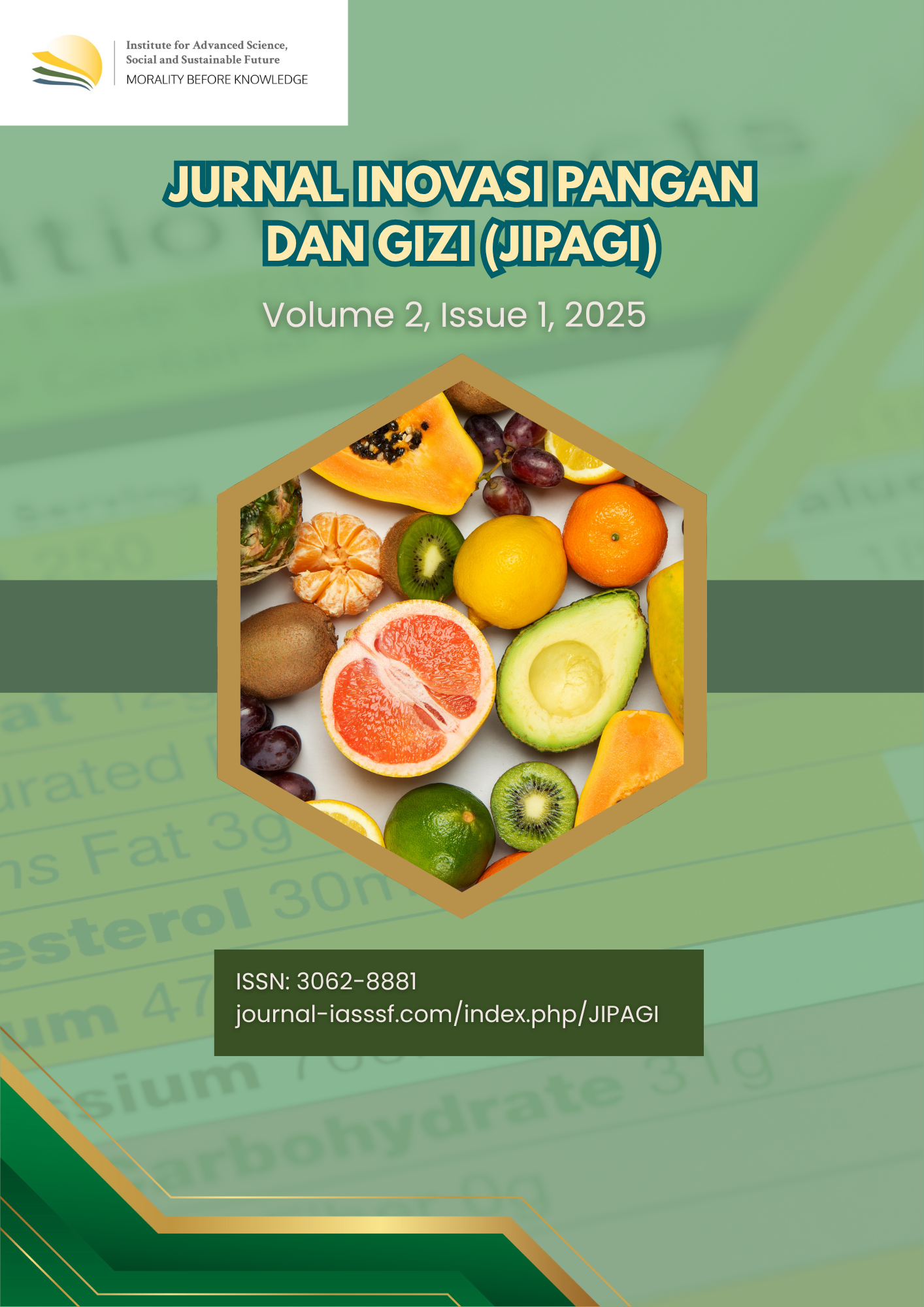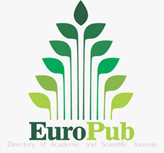Study on the effect of carboxymethyl cellulose (CMC) concentration on the quality of lacum fruit syrup (Cayratia trifolia (L.) Domin)
DOI:
https://doi.org/10.61511/jipagi.v2i1.1503Keywords:
carboxymethyl cellulose, lacum fruit, potential in society, syrupAbstract
Background : Syrup made from lacum fruit is one of the efforts to diversify processed products. The use of lacum fruit as a processed product has great potential in society, because the vitamin C content in lacum fruit has properties and benefits for the human body. Method: This study used a Randomized Block Design (RAK) with one factor, namely variations in CMC concentration with 5 levels, consisting of CMC 0%, CMC 0.5%, CMC 1%, CMC 1.5% and CMC 2%. Findings: CMC administration had a very strong tendency towards the characteristics of total dissolved solids, pH, the L* values obtained tended to increase but the a* (reddish) and b* (yellowish) values tended to decrease. Conclusion: The best lacum fruit syrup is syrup with a CMC concentration of 1% which produces an average chemical test in the form of a Total Dissolved Solids test of 45.80o Brix, a pH test of 3.93, an L color of 12.58, a* 2.52 and b* 0.26. The best sensory test results were color 3.81 (like), aroma 3.42 (like), taste 3.77 (like) and viscosity 3.77 (like). Novelty/Originality of This Study:This study explores the effect of varying carboxymethyl cellulose (CMC) concentrations on the physicochemical and sensory qualities of lacum fruit syrup. It provides new insights into the optimization of CMC for enhancing the quality of local fruit-based beverages.
References
Amar, A., Suryawati, A., & Nurani, D. (2020, April). The effect of carboxy-methyl-cellulose (CMC) concentration on suspension stability of red guava syrup (Psidium guajava L) during storage. In IOP Conference Series: Earth and Environmental Science (Vol. 472, No. 1, p. 012005). IOP Publishing. https://doi.org/10.1088/1755-1315/472/1/012005
Amriani, H., Syam, H., & Wijaya, M. (2019). Pembuatan teh fungsional berbahan dasar buah mahkota dewa (Phaleria macrocarpa) dengan penambahan daun stevia. Jurnal Pendidikan Teknologi Pertanian, 5(1), 251-261. http://dx.doi.org/10.26858/jptp.v5i0.9085
Antarlina, S. S. (2009). Identifikasi sifat fisik dan kimia buah-buahan lokal Kalimantan. Buletin Plasma Nutfah, 15(2).
Apriyantono, A., Fardiaz, D., Puspitasari, N. L., Sedarnawati, B. S., & Budiyanto, D. S. (1989). Analisis pangan. Bogor. Pusat Antar Universitas Pangan dan Gizi, IPB.
Bansal, S., & Aggarwal, D. (2011). Color image segmentation using CIELab color space using ant colony optimization. International Journal of Computer Applications, 29(9), 28-34. https://research.ijcaonline.org/volume29/number9/pxc3874978.pdf
De Garmo, E.D., Sullivan, W.G., & J.R Canada. (1984). Engineering Economy. Milan Publishing Company.
Farikha, I. N., Anam, C., & Widowati, E. (2013). Pengaruh jenis dan konsentrasi bahan penstabil alami terhadap karakteristik fisikokimia sari buah naga merah (Hylocereus polyrhizus) selama penyimpanan. Jurnal Teknosains Pangan, 2(1), 30-38. https://jurnal.uns.ac.id/teknosains-pangan/article/viewFile/4206/3632
Fitriani, N., Dewi, Y. K., & Purwayantie, S. (2020). Pengaruh Perbandingan Konsentrasi Sukrosa dan CMC (Carboxy Methyl Cellulose) Terhadap Mutu Sirup Buah Cempedak (Artocarpus Champeden). Universitas Tanjungpura Pontianak.
Fitriyaningtyas, S. I., & Widyaningsih, T. D. (2015). Pengaruh penggunaan lesitin dan CMC terhadap sifat fisik, kimia, dan organoleptik margarin sari apel manalagi (Malus sylfertris Mill) tersuplementasi minyak kacang tanah. Jurnal Pangan dan Agroindustri, 3(1), 226-236. https://jpa.ub.ac.id/index.php/jpa/article/view/127/0
Ganz, A. Z. (1997). Celluulose Hydrocolloids. Dalam H.D. Graham (eds). Food Colloids. The AVI Publissing Company.
Hartatie, E. S. (2011). Kajian formulasi (bahan baku, bahan pemantap) dan metode pembuatan terhadap kualitas es krim. Jurnal Gamma, 7(1). https://ejournal.umm.ac.id/index.php/gamma/article/view/1415
Harun, N., & Yucha, E. S. (2013). Penambahan Gula Kelapa dan Lama Fermentasi Terhadap Kualitas Susu Fermentasi Kacang Merah (Phaesolus vulgaris L.). Sagu, 12, 9-16.
Isniawan, V., Subagyo, Y., & Utami, S. (2013). Pengaruh Persentase Penambahan Madu dengan Lama Penyimpanan yang Berbeda terhadap pH dan Uji Alkohol Susu Kambing. Jurnal Ilmiah Peternakan, 1(1), 79-87. https://doi.org/10.21776/ub.jitek.2017.012.02.4
Istiqomah, K., Praptiningsih, Y., & Windrati, W. S. (2017). Karakterisasi es krim edamame dengan variasi jenis dan jumlah penstabil. Jurnal Agroteknologi, 11(02), 139-147. https://doi.org/10.19184/j-agt.v11i02.6522
Manoi, F. (2006). Pengaruh konsentrasi karboksil metil selulosa (CMC) terhadap mutu sirup jambu mete (Anacardium occidentale L.). Buletin Littro, 17(2), 72-78. https://repository.pertanian.go.id/handle/123456789/3607
Nicol, W.M. (1979). Sucrose and food technology. In: Sugar: Science and Technology. Applied Science Publishers.
Novelina, N., Siswardjono, S., & Efrina, E. (2012). Studi Pembuatan Minuman dari Daun Lidah Buaya (Aloe vera) dengan Penambahan Penstabil Terhadap Mutu Produk. Jurnal Teknologi Pertanian Andalas, 15(2), 95-103. http://repository.unand.ac.id/23786/
Polnaya, F. J., & Breemer, R. (2016). Karakteristik sifat-sifat kimia dan organoleptik kue kering berbahan dasar pati sagu, ubi kayu, ubi jalar dan keladi. AGRITEKNO: Jurnal Teknologi Pertanian, 5(1), 1-6. https://doi.org/10.30598/jagritekno.2016.5.1.1
Prabandari, W. (2011). Pengaruh penambahan berbagai jenis bahan penstabil terhadap karakteristik fisikokimia dan organoleptik yoghurt jagung. Universitas Sebelas Maret.
Pramitasari, D. (2010). Penambahan ekstrak jahe (zingiber officinale rosc.) dalam pembuatan susu kedelai bubuk instan dengan metode spray drying: komposisi kimia, sifat sensoris dan aktivitas antioksidan. Universitas Sebelas Maret.
Putra, I. M. A. W., Nirmala, B. M. S., Liandana, M., Kom, S., Bali, T. K. S., & No, J. R. P. (2016). Perbandingan Hasil Segmentasi pada Masing-Masing Kanal Ruang Warna untuk Memunculkan Fitur Plasmodium pada Thin Blood Films. In Prosiding Seminar Nasional Pendidikan Teknik Informatika (SENAPATI 2016), Senapati.
Rachmat, E., & Cahyanti, M. (2010). Algoritma Transformasi Ruang Warna. Universitas Ahmad Dahlan.
Rahayu, W. P. (1998). Diktat Penentuan Praktikum Penilaian Organoleptik. Institut Pertanian Bogor.
Rienoviar, N. H. (2010). Penggunaan asam askorbat (vitamin C) untuk meningkatkan daya simpan sirup rosela (Hibiscus sabdariffa Linn.). Jurnal Hasil Penelitian Industri, 3(1), 8-18.
Rivaldi, S., Yunus, Y., & Munawar, A. A. (2019). Prediksi Kadar Total Padatan Terlarut (TPT) dan Vitamin C Buah Mangga Arumanis (Mangifera indica L) Menggunakan Near Infrared Spectroscopy (NIRS) dengan Metode Partial Least Square (PLS). Jurnal Ilmiah Mahasiswa Pertanian, 4(2), 349-358. https://doi.org/10.17969/jimfp.v4i2.10916
Satuhu, S. (2004). Penanganan dan pengolahan buah. Penerbar Swadaya.
Shofiati, A., Andriani, M. A. M., & Choirul, A. (2014). Kajian kapasitas antioksidan dan penerimaan sensoris teh celup kulit buah naga (pitaya fruit) dengan penambahan kulit jeruk lemon dan stevia. Jurnal Tekno sains Pangan, 3(2). https://jurnal.uns.ac.id/teknosains-pangan/article/view/4632
Sopandi, D. H. (1989). Pengaruh jenis dan konsentrasi penstabil terhadap mutu sari buah jambu biji (Psidium guajava L.) selama penyimpanan. Fateta IPB Bogor.
Susanty, A., & Sampepana, E. (2017). Pengaruh masa simpan buah terhadap kualitas sari buah naga merah (Hylocereus polyrhizus). Indonesian Journal of Industrial Research, 12(2), 76-82. https://doi.org/10.26578/jrti.v11i2.3011
Tranggono. (1990). Bahan Tambahan Pangan (food additives). Pusat Antar Universitas Pangan dan Gizi.
Winarno, F. G. (2008). Kimia Pangan dan Gizi. PT Gramedia Pustaka Utama.
Downloads
Published
How to Cite
Issue
Section
Citation Check
License
Copyright (c) 2025 Qhori Ramadan, Suko Priyono, Nur Endah Saputri

This work is licensed under a Creative Commons Attribution 4.0 International License.















